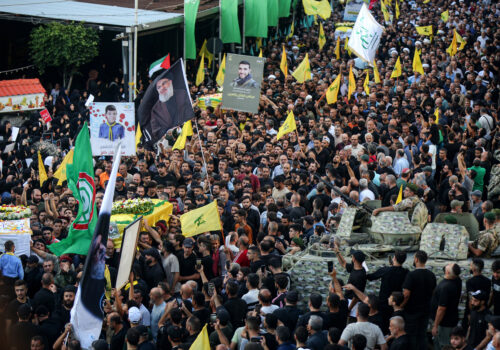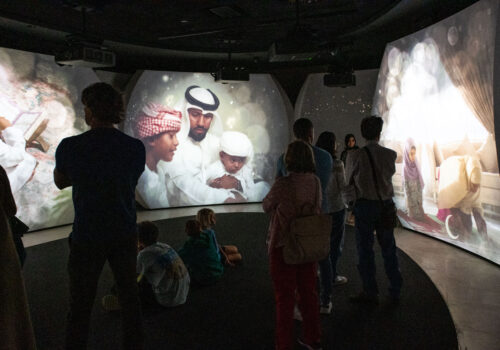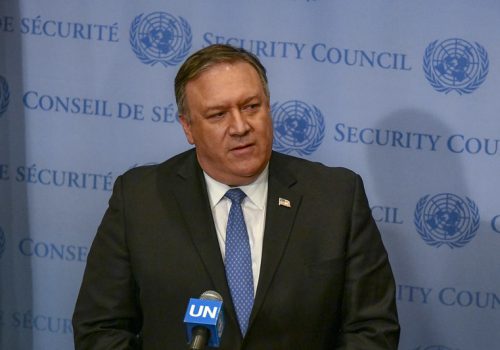
Testimony on Israel and the Middle East at a crossroads: How Tehran’s terror campaign threatens the US and our allies

Kirsten Fontenrose, nonresident senior fellow at the Scowcroft Middle East Security Initiative in the Atlantic Council’s Middle East Programs, testifies before the US House Committee on Foreign Affairs on how Tehran’s terror campaign threatens the US and allies. Below are her prepared remarks.
Chairman Burchett, Ranking Member Phillips, and members of the Committee, thank you for the opportunity to testify. I served as the Senior Director for Gulf Affairs at the National Security Council for 2018, after nearly twenty years of service focused on the Middle East and Africa at the Department of Defense, Department of State and other branches of government. In each role I witnessed the advancement of a positive American agenda for catalyzing strong security partners, welcoming markets, and stable governments across the Middle East stymied by a determination in Tehran to undermine U.S. partnerships and extirpate U.S. influence from Marrakesh to Bangladesh.
This influence underpins American economic power in the region, opening doors for American businesses, increasing access to critical natural and technical resources, and ensuring strong currencies are tightly intertwined with the dollar. It underpins the U.S.’ ability to sustain strategic reach without a large footprint, creating demand to equip and train militaries with whom the U.S. can plug-and-play when necessary. It underpins the willingness of regional partners to engage with the U.S. on ways to expand civil liberties and personal freedoms anathema to Iran’s oppressive theocracy.
I closely track the Islamic Revolutionary Guard Corps’ (IRGC) development of weaponry. Because of growth in their missile and drone programs, accelerated by the lapse of U.N. sanctions and provisions in UNSCR 2231 in 2020 and 2023, Iran is now able to deliver lethal effects to every country in the Middle East.
Iran has learned to exploit swings in U.S. policy, divisions between the U.S. and partners in Europe and the Middle East, the openness of American society, commercially available dual-use technology, and criminal gangs in their multi-pronged, terrorism-based effort to ensure the regime’s survival and weaken U.S. resolve. In the last three administrations the U.S. strove to alter Iran’s foreign policy using carrots, then sticks, then carrots again. What has not been tried is a long-term, multi-domain, bipartisan strategy for addressing Iran’s goal to unseat the U.S. as the partner of choice for many important Arab states.
Tehran Believes it is Winning
Iran does not want a full-scale war in the Middle East at this moment. Leaders in Tehran do not seek to invite American military operations against their homeland. In their estimation, making the region inhospitable to U.S. forces is the more prudent way to actualize the Supreme Leader’s vision of a “great estate” in which the theocracy dictates the foreign policy of western Asia.
With this goal in mind, Tehran believes it is winning, at low cost. Iran’s lesson learned from the Gaza conflict is that the return on their investment in Hamas, the Houthis, Hezbollah and lesser militias has paid off handsomely: U.S. society is divided; Israeli society is divided; the U.S.-Israel relationship is strained; the U.S. reputation internationally is tarnished; 60,000 Israelis are displaced from the northern border; the Abraham Accords are paused; militias in Syria and Iraq are sustaining pressure on U.S. troops; and maintaining a heightened defense posture at home and at its embassies globally while Tehran deliberates retaliation for the deaths of Ismail Haniyeh and Fuad Shukr is straining Israel’s manpower and budget.
This upheaval is equally useful to Tehran in distracting attention in western capitals from IRGC operations that should be the focus of a coordinated coalition counter effort. These operations are poorly addressed and merit smarter action in cooperation with partners:
- Houthi attacks on global shipping from Yemen. All 6 types of anti-ship ballistic missiles and 4 of the 6 types of cruise missiles used by the Houthis in attacking ships in the Red Sea are provided by Iran or fitted with Iranian guidance kits. Protecting the freedom of navigation in global shipping lanes is a top U.S. objective per both the U.S. National Security Strategy and National Defense Strategy, yet the U.S. currently outsources implementation of this objective to European navies with a fraction of the U.S. capability to address it.
- Ties to terrorist groups with American blood on their hands. In the astute words of a 30-year veteran of the U.S. intelligence community with deep knowledge of Iran’s covert activities, “Iran is the only country in the world that has maintained a relationship with Al Qaeda – to include allowing an active Al Qaeda facilitation cell on its territory – without paying a price.”
- Ties to criminal networks in the U.S. and Europe in the service of assassination and kidnapping plots. Operations to silence journalists and dissidents abroad have been a pillar of Iran’s foreign policy for 40 years. These have evolved in an alarming way, as reported by the Washington Post on September 12th of this year. Western intelligence services accustomed to tracking IRGC Quds Force operatives see a new reliance on western criminal networks who traverse borders with ease. The Financial Times has reported on attempts by Iran and Hezbollah to acquire weapons from drug cartels.
- Disinformation campaigns to divide America from within. Microsoft and Open AI discovered 5 Iran-backed websites aimed at English speakers globally that promulgate false narratives about the U.S. The Foundation for Defense of Democracies identified 14 more. Examples include “Afro Majority” which targets African Americans, and “Not Our War” targeting American veterans. Specific to the war in Gaza, Iran removed the data in a Palestinian polling group’s survey results and replaced them with false numbers that implied an inaccurately high rate of Palestinian support for Hamas as future leaders of Gaza. In the summer of 2024 U.S. ODNI revealed that Tehran sponsored anti-Israel protests on U.S. college campuses and attempted hacks on the Presidential campaigns of both major U.S. political parties. Iran’s alignment with China in the pursuit of sowing division among American communities gives the regime unfettered access to American youth via Chinese-owned social media platforms. To apply a military term, Iran and China are engaged in Phase 0 (pre conflict) shaping of the environment in the U.S., continuously exposing Americans to disinformation. Without hyperbole, the risk in not addressing this activity is that future generations of American decision makers will be fed an unhealthy dose of what our adversaries want them to consume.
- Sales of ballistic missiles and drones to aid Russia’s invasion of Ukraine. The U.S. and European partners were aghast when Iran sold Shahed series attack drones to Russia yet actions did nothing to deter further sales. Russia now produces those drones domestically, geometrically increasing their use on the battlefield. Iran followed with the sale of Fatteh-136 short range ballistic missiles. The only effective defense against these missiles are Patriot interceptors, which are expensive and in low stock. Looking forward, it is logical to expect the Iran-Russia weapons program propinquity to expand to co-development and production of new weaponry.
Calculus in Tehran
The Permanent Mission of the Islamic Republic of Iran to the United Nations (U.N.) denied this missile transfer. The framing of this denial is important because it illustrates the duplicity inherent in the regime’s foreign policy, and it is as ironic in the context of Gaza as it is in Ukraine: “Iran’s position vis-à-vis the Ukraine conflict remains unchanged. Iran considers the provision of military assistance to the parties engaged in the conflict – which leads to increased human casualties, destruction of infrastructure, and a distancing from ceasefire negotiations – to be inhumane. Thus, not only does Iran abstain from engaging in such actions itself, but it also calls upon other countries to cease the supply of weapons to the sides involved in the conflict.”
Iran recently elected a President marketed as a “moderate” in a vote with the lowest turnout in the regime’s history. While President Pezashkian may truly harbor dreams of reform, he is in no position to enact them. His engineered election is proof of a shrewd calculation by the regime inner circle. They expect that offering new nuclear negotiations may entice a Harris administration or create obstacles for a Trump administration in ways that protect the regime’s interests.
Being at the table for nuclear talks has proven to be a sweet spot for this regime. The talks are the goal. They have no intention of signing a deal. Tehran expects that if a Harris administration takes the helm they can freeze nuclear enrichment while engaging in talks and this will result in lackadaisical sanctions enforcement. This allows the continuation of roughly 1.5 million barrels per day of oil and up to 300,000 barrels per day of condensate exports. Combined with production for domestic use, Iran’s production is just half a million barrels less than they could produce sustainably in a wholly unsanctioned environment according to industry analysts.
Iran’s President Pezashkian said Iran needs more than $100 billion in foreign investment, and the lack of sanctions enforcement is also hoped to entice foreign investment from the UAE and Saudi Arabia. All without closing a centrifuge or disposing of enriched material.
If a Trump administration takes office, Tehran reasons that the window dressing provided by a few moderate officials and their current hints at willingness to restart nuclear talks will convince the international community to reject U.S. requests to reapply maximum economic pressure.
However, a close look at the new Cabinet formed by President Pezashkian confirms that the regime remains committed to hardline policies. At least three are members of the IRGC, including those who control the Ministries of Intelligence, Justice, and Interior.
The Regime’s Technology Toolbox
Cyber. In addition to the nuclear program and terrorist proxy sponsorship, Iran invests in deadly military hardware and software, projects it defends as critical foreign policy tools.
The Economist’s Byte by Byte podcast calculated the increase in Iranian cyber attack activity since October 7thof last year at 300%. While Iran’s cyber capability does not yet match that of Israel, it is improving consistently. In the Arab world, Iran’s capability is comparable to that of the United Arab Emirates, but at a larger scale. Vulnerabilities that previously took Iranian cyber actors weeks to exploit now take days. Iran has transferred cyber expertise to Hezbollah and could choose to offer the same to additional armed groups. Of concern to Israel is the possibility that advanced cyber techniques or tools could be passed by Russia to Iran as part of their expanding security interdependency.
Missiles and Drones. Despite a flurry of U.S. effort to prevent it, the U.N. arms embargo on Iran expired in October of 2020. As I warned would happen in an article the previous June titled “The Gulf is Watching Washington’s Moves on the UN Embargo on Iran”, Iran has made lethal strides in its missile and drone programs. The IRGC has added new ballistic missiles to their arsenal and extended the range and accuracy of pre-existing models. The new missiles display improved precision in tests, thanks to the acquisition of better guidance systems and better targeting technology. Iran has advanced its utilization of solid fuel technology, making IRGC missiles easier to transport and faster to launch – therefore harder to detect and preemptively strike. Iran’s cruise missiles and drones also boast extended ranges, better guidance systems, longer flight durations. Drone payload capacity has also been improved, both in size and quality, with the import of advanced surveillance technologies, for example.
Iran extends this largesse to its affiliates across the region. With specific regard to the crippling of Red Sea shipping, note that the International Institute for Strategic Studies wrote in October of 2023 “With Iranian assistance, the Houthis have managed to build up an array of precisionguided rockets, ballistic missiles, land attack cruise missiles and anti-shipping capabilities in a remarkably short period of time.” In February of this year the IRGC Navy fired two ballistic missiles from a ship for the first time. This capability equates to an extension of its missile arsenal range.
In October of 2023 restrictions on Iran’s missile program under UNSCR 2231 ended. These restrictions prevented Iran from importing or exporting missiles, drones, or components of either. At the time of its expiration 48 states signed a statement calling Iran’s missile program “one of the greatest challenges to international non-proliferation efforts” and stressing that Iran’s foreign policy of arming militias abroad “endangers international stability and escalates regional tension.” According to the U.N., Iran’s sale of ballistic missiles to Russia is legal.
UNSCR 2231 also prohibited Iran from converting missiles into nuclear delivery vehicles. Iran did not abide by this prohibition while it was active, but the expiration of these restrictions means IRGC work in this area is unencumbered.
A Note on Nukes. Perhaps the greatest danger posed by Iran’s missile program is its potential to deliver a nuclear warhead. The series most likely to serve this purpose in the IRGC arsenal today are, in order of capability, the Khorramshar 1/2, the Shahab-3, the Emad. Should Iran cross the threshold of nuclear weaponization, the risk of deadly escalation in any exchange of fire between Iran and Israel will spike, due to payload uncertainty. Barring intelligence to the contrary, any missile of a nuclear-capable variant fired from Iran would be assumed to carry a nuclear payload. In a wargame the scenario becomes mutually assured destruction.
The conflict in Gaza, the war in Ukraine, the war in Yemen, and the nonsensical Houthi campaign against global shipping are all laboratories in which Iranian engineers study and tweak IRGC weaponry. Allowing Iran’s partners to continue deploying Iranian munitions in these theaters effectively furthers Iranian R&D.
What the U.S. Can Do About It
Congressional Action. While altering Iranian behavior is a complex task, altering our own should not be.
- Iran’s missile sales to Russia provide ample justification for passing legislation that truncates the process for transferring to Ukraine weapons seized in intercepted Iranian shipments to proxies. When Iranian weapons are used against Russia, it could be in Russia’s interest to pressure Iran to halt those shipments.
- Iranian meddling in the election campaigns of America’s two largest political parties must be fully understood to be mitigated. Congress could urge the appointment of a Special Counsel and establish a bipartisan task force to draft policy recommendations based on the Special Counsel’s findings.
- The dangerous spectrum of Iranian actions designed to abrogate U.S. influence from the Middle East justifies the framing of a unified strategy, perhaps by a Select Committee, that reflects the U.S. mission to see an Iran that does not possess a nuclear weapon, does not sponsor terrorism, does not suppress the will of its people, and does not interfere with U.S.
elections or the American social fabric.
Diplomacy. The sanctions, military deterrence, and diplomacy drawn on in successive attempts to change these Iranian behaviors remain valid tools but require tweaking. Diplomatic efforts should be in the service of forming and mobilizing a coalition to refine and adopt the Americanled strategy instead of in the service of exchanging messages with intransigent Iranian nuclear negotiators or Hamas representatives.
I recommend the coalition adopt a position that rejects the entry of missiles and drones into sovereign airspace and waters without approval and assigns repercussions for violations. Further, that the coalition be mobilized to disrupt operations that enable the Iranian programs that have violated and continue to violate this position. Finally, that the coalition discuss with Iran and, barring improvement, announce that should Iran continue to destabilize and suppress economic growth in either or all of Lebanon, Yemen, the Palestinian territories, Syria and Iraq, the bill for resultant reconstruction projects will be Iran’s and not born by any members of the Coalition. This announcement could lead to populations of these countries reassessing Iran’s role in their midst.
This coalition should agree on and publish actions that will be taken against Iran when a citizen of a coalition member country is kidnapped by the IRGC anywhere in the world. Stronger action should be triggered when a citizen is assassinated, or an assassination is attempted. Heeding human rights lawyers, the U.S. should push for universal jurisdiction tools to be applied to Iran by the coalition. Many countries currently refrain from doing so due to fear of retributive kidnappings. The coalition should agree to open structural investigations into human rights abuses at the hands of Iranian officials where victims who can provide evidence have moved into jurisdictions that can host criminal trials or file for civil litigation.
Note that this discussion of a coalition is entirely removed from discussions of military posture or action. Separating these asks makes it easier for partner nations to participate at the level supported by their populace.
Military Deterrence. Diplomacy has not – and arguably cannot – reduce Iran’s intent to conduct acts of terror. Deterrence is established when an enemy believes they have more to lose than gain from a hostile action. Iran’s Supreme Leader, as the head of a nation with near absolute power, has quite a bit to lose. This logic underpins Iran’s proxy-based foreign policy. Potential losses are offloaded to external entities, increasing Iran’s risk tolerance. This is also why Iran has refused to negotiate on its support of proxies like it has on its nuclear program. The value of proxies far outweighs the cost of arming them and treating them as negotiable would fray their loyalty.
How to counter this logic? The U.S. has shied away from kinetic action inside Iran over several administrations with good reason. Tehran understands that primary among these were U.S. concerns about civilian loss of life and the risk of fomenting popular support for the regime. Advances in precision weaponry drastically reduce these risks. Following Iran’s April 13th multifront drone and missile attack on Israel, Israel’s 3-missile strike on a Russian-made S300 air defense system near one of the IRGC’s nuclear sites elicited nary a blink from average Iranians. The U.S. should make it clear to the leadership of Iran’s proxy, drone and missile programs that new capabilities now permit the U.S. and partners to dismantle their facilities and chains of command with low to no risk of negative secondary effects. Though “AUMF” is a four letter word in Congress, an Authorized Use of Military Force could convey this quickly and clearly.
The barrage of munitions fired from Iranian and proxy stockpiles on April 13th in what the IRGC termed Operation True Promise was a test of both Israel’s air defenses and the US-led network of countries pledged to peace with Israel. Since then, Iran has worked to undermine and to court America’s partners in the region. Years of CENTCOM engagement are one reason this work has so far failed. But integrated air and missile defense (IAMD) is not yet fully realized and neither our partner nations nor our citizens are well-protected from Iranian weaponry. The Diplomatic Security Service can be asked to provide details on the threat level from missiles and drones to our embassies abroad, especially in countries where Iran has influence and affiliates.
Sanctions. Acknowledging debate about the effectiveness of current sanctions on Iran, there is reason for optimism. In 2023 Treasury was mainstreaming AI in sanctions research, per their 2021 modernization agenda. As these specialized AI tools continue to learn and be applied, the depth of research and speed the U.S. applies to uncovering IRGC front companies and compiling cases for targeted sanctions will accelerate. These tools will also enable a more thorough application of secondary sanctions against brokers and facilitators anywhere in the world who play middleman in the Chinese-Iranian oil trade or Iran’s drone sales in Africa, Central Asia, and Latin America.
UNSCR 2231 sanctions on Iran’s authority to enrich uranium will expire in October 2025 unless snapback is triggered. Iran has threatened to immediately weaponize if this occurs and pre-2015 sanctions are automatically reimposed. While U.S. issuance of and adherence to redlines has been abysmal, consecutive administrations have been clear that Iranian possession of a nuclear weapon will not be countenanced. The current US military posture in the region presents a credible deterrent. Iran will certainly weigh these two data points. The U.S. should create conditions for Iran to walk back their threat without loss of face.
Go for a Grand Bargain. The regime in Iran has learned from a dozen years of experimentation that its interests are best served by focusing the attention of the U.S. Government on a single issue while operating with no impediments elsewhere. That single issue, the nuclear file, has reached a point where Iran has very little room to continue slowly ramping up the program to keep the U.S. riveted. IRGC intent is no doubt to mature the missile, drone and proxy programs to the point that any one of them can be peeled off to serve as the next single issue of focus. To prevent another dozen years of IRGC terrorist capability advances, the U.S. should consider crafting a grand bargain comprised of carrots and sticks that establishes deterrence while allowing the partial fulfillment of an Iranian objective where it also overlaps with U.S. interests.
While designing a multifaceted deal will be complex, the last 12 years prove that addressing the range of Iran’s hostile behaviors individually is even less likely to yield results.
Elements could include an end to Iranian arms transfers and financial support to designated terrorist groups in other sovereign countries; a roll back of Iranian stockpiles of enriched uranium; the proportional removal of U.S. sanctions related to the nuclear program and sponsorship of terrorism; a U.S. greenlight for foreign direct investment into Iran from Saudi Arabia and the UAE in agreed-upon sectors; the continuation of U.S. and Arab state plans for IAMD and burgeoning initiatives like the Comprehensive Security Integration and Prosperity Agreement (C-SIPA), as the military activities in each are purely defensive; the continuation of Iran and Arab state cooperation ensuring mutual non-aggression and developing trade; U.S. and European cooperation with the region to establish a non-binding regional security conflict resolution mechanism for the Middle East with membership extended to both Iran and Israel; a gradual draw down of U.S. forces present in the region without the request of the host government and potential further reductions in U.S. troop presence pending Arab partners assurances to the U.S. that Iran does not demonstrate hostile intent and/or that strengthened U.S.-Arab security arrangements are sufficient. Note that such strengthened security agreements do not have to include a quartered troop commitment, rather they can be a U.S. commitment to respond if the partner is attacked.
The U.S. should not expect any deal reached to be more than a set of transactional arrangements. The U.S. and Iran did find ground to cooperate after 9/11 against the Taliban and later against ISIS in Iraq, when neither country wished to see a Sunni terrorist group establish a stronghold in the region. The U.S. also provided humanitarian assistance to Iran after the Bam earthquake in 2003. Most other instances of cooperation have emerged not due to shared objectives but because Iran conducted an aggressive act the U.S. was then compelled to mitigate, like when exchanging Iranian prisoners for kidnapped Americans, negotiating the JCPOA to limit Iran’s nuclear program, or signing the Algiers Accord in 1981 after Iran held 52 Americans hostage for 444 days.
Time spent negotiating a grand bargain is also time available in parallel lanes to develop new tools for future use in dismantling the nuclear or missile and drone programs as required. If no deal is reached, the U.S. should have contingency plans on the shelf for applying additional sanctions, conducting strikes, or implementing other options inside or outside of Iran.
Conclusion
Without U.S. leadership, October 2025 will mark the end of any mechanism for reimposing U.N.
sanctions on Iran’s nuclear, missile or drone programs. Tehran will be free to pursue further tools of terror and coercive expansionism. The interests of all actors, including Iranians, are better served by curtailing this.
We are currently in a rare period of widespread transitions among actors in this space. The time is opportune to reset norms, establish red lines, and devise an updated approach for managing Iran’s hegemonic aspirations, incorporating lessons from the past 12 years of US strategy and four years of unencumbered Iranian weapons advancements.
There is tragic irony in the fact that the U.S. and Iran share the same goal of someday seeing a smaller U.S. footprint in the Middle East. The U.S. keeps 40,000 troops in the region in large part because of requests from Arab partners for defense against an Iran they see as hostile. Were Iran to reduce its harassment of these neighbors, the U.S. would see less reason to be present and would pull troops home. Tehran would be smarter to discuss with Arab states its discontent with the continued U.S. presence, rather than directing attacks on U.S. troops. The latter only underscores the threat perception that keeps the U.S. there.

Through our Rafik Hariri Center for the Middle East and Scowcroft Middle East Security Initiative, the Atlantic Council works with allies and partners in Europe and the wider Middle East to protect US interests, build peace and security, and unlock the human potential of the region.
Further reading
Wed, Sep 18, 2024
Experts react: What’s behind the Hezbollah beeper and walkie-talkie explosions
Experts react By Atlantic Council experts
Our experts explain what the explosions of communication devices in Lebanon could mean for the conflict between Israel and Hezbollah.
Wed, Sep 11, 2024
As the Israel-Hamas war continues, the Abraham Accords quietly turns four
MENASource By Marcy Grossman
The Abraham Accords have laid a foundation far beyond any one conflict for greater peace in the region.
Thu, Dec 5, 2019
Assessing US policy toward Iran
IranSource By Kenneth Katzman
The effectiveness of any US policy needs to be measured against the primary objective it is seeking to accomplish. A policy might be changing some conditions in a target country, but not others. The conditions that are being changed by US policy might be material to US interests, or they might not. The key question […]


